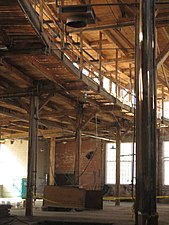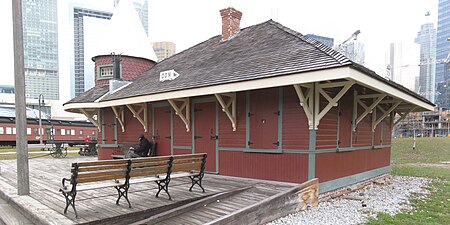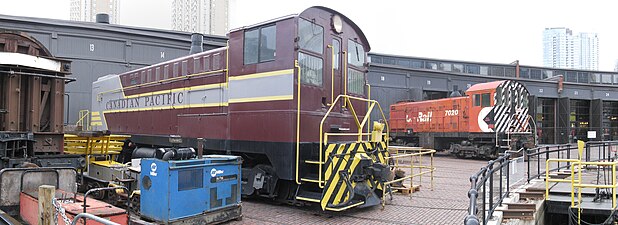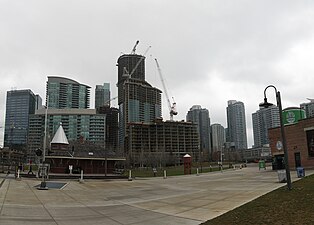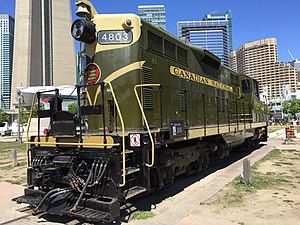
The Canadian Pacific Railway, also known simply as CPR or Canadian Pacific and formerly as CP Rail (1968–1996), was a Canadian Class I railway incorporated in 1881. The railway was owned by Canadian Pacific Railway Limited, which began operations as legal owner in a corporate restructuring in 2001.

The Minnesota Transportation Museum is a transportation museum in Saint Paul, Minnesota, United States.
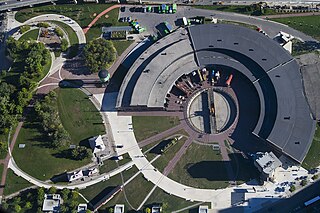
A railway roundhouse is a building with a circular or semicircular shape used by railways for servicing and storing locomotives. Traditionally, though not always the case today, these buildings surrounded or were adjacent to a turntable.
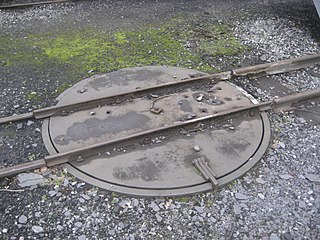
In rail terminology, a railway turntable or wheelhouse is a device for turning railway rolling stock, usually locomotives, so that they can be moved back in the direction from which they came. it is especially used in areas where economic considerations or a lack of sufficient space have served to weigh against the construction of a turnaround wye. In the case of steam locomotives, railways needed a way to turn the locomotives around for return trips as their controls were often not configured for extended periods of running in reverse and in many locomotives the top speed was lower in reverse motion. In the case of diesel locomotives, though most can be operated in either direction, they are treated as having "front ends" and "rear ends". When a diesel locomotive is operated as a single unit, the railway company often prefers, or requires, that it be run "front end" first. When operated as part of a multiple unit locomotive consist, the locomotives can be arranged so that the consist can be operated "front end first" no matter which direction the consist is pointed. Turntables were also used to turn observation cars so that their windowed lounge ends faced toward the rear of the train.
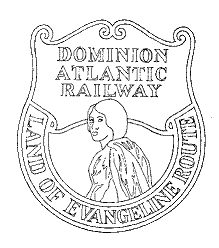
The Dominion Atlantic Railway was a historic railway which operated in the western part of Nova Scotia in Canada, primarily through an agricultural district known as the Annapolis Valley.

The Royal Hudsons are a series of semi-streamlined 4-6-4 "Hudson" type steam locomotives formerly owned and operated by the Canadian Pacific Railway (CPR) and built by Montreal Locomotive Works (MLW). The engines were built in 1937. In 1939, King George VI allowed the CPR to use the term after Royal Hudson number 2850 transported the royal train across Canada with no need of replacement. These locomotives were in service between 1937 and 1960. Four of them have been preserved. No. 2839 was used to power excursions for the Southern Railway Steam Program between 1979 and 1980. No. 2860 was used for excursion service in British Columbia between 1974 and 1999, then again between 2006 and 2010.

The York–Durham Heritage Railway was a heritage railway in both the York Region and the Durham Region of Ontario, Canada, north of Toronto.

The Morris Park Facility is a maintenance facility of the Long Island Rail Road in Queens, New York City. It includes two employee-only side platforms on the Atlantic Branch named Boland's Landing. Two wooden platforms, each two cars long, exist on the two-track line, with a flashlight for workers to signal trains to stop.

The CNR Spadina Roundhouse was owned by the Canadian National Railway, built in 1928. The purpose of Spadina Roundhouse was the pretrip inspection, service and repairing of the motive power of passenger trains, including locomotives and Budd Rail Diesel Cars terminating, or originating at Toronto Union Station.

CPKC West Toronto Yard is a small marshalling yard for the Canadian Pacific Kansas City on the Galt Subdivision in Toronto, Ontario, Canada. The yard was built in 1882 to relieve stress at the Parkdale Yard and is located near Keele Street and Dundas Street West in The Junction. It was once the main yards for Toronto, but was replaced in that role in April 1964 by the CPR Toronto Yard in Agincourt. The roundhouse was demolished in 1998.

Canadian National 6213 is a preserved 4-8-4 steam locomotive on static display in Toronto, Ontario, Canada at the Toronto Railway Museum (TRM) on the lands of the former CPR John St. Roundhouse. It was on active duty until 1959 and was donated by Canadian National Railway (CNR) to the City of Toronto government in 1960. It was on display at Exhibition Place until 2009 when it was moved to its current location.

Railway Lands is an area in Downtown Toronto, Ontario, Canada. Originally a large railway switching yard near the Toronto waterfront, including the CNR Spadina Roundhouse and the CPR John Roundhouse, it has since been redeveloped and today is home to mostly mixed-used development, including the CN Tower and the Rogers Centre. The lands were owned and maintained by the Canadian National Railway and later transferred to the federal crown corporation Canada Lands Company. The area is bounded by Front Street, Yonge Street, Gardiner Expressway and Bathurst Street. The western portion of the Railway Lands is now part of the CityPlace neighbourhood and the eastern portion is now called South Core.
There were a number of engine sheds and railway works located in York. The large York North engine shed became the National Railway Museum in 1975.
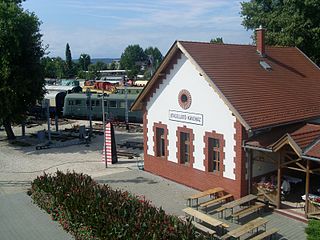
The Magyar Vasúttörténeti Park is a railway museum located in Budapest, Hungary at a railway station and workshop of the Hungarian State Railways (MÁV), the former Budapest North Depot. The museum covers more than 70,000 square meters and it features over one hundred exhibits, mostly including railway vehicles and equipment.
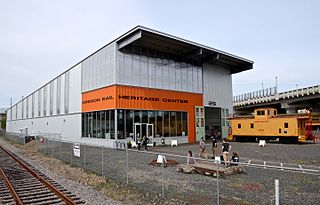
The Oregon Rail Heritage Center (ORHC) is a railway museum in Portland, Oregon. Along with other rolling stock, the museum houses three steam locomotives owned by the City of Portland: Southern Pacific 4449, Spokane, Portland & Seattle 700, and Oregon Railroad & Navigation Co. 197, the first two of which are restored and operable. The center opened to the public on September 22, 2012. The project to establish the center was led by the Oregon Rail Heritage Foundation (ORHF), a non-profit organization, which was renamed from the Oregon Heritage Steam Foundation in 2002. The non-profit Oregon Steam Heritage Foundation was formed in 2000. The museum site is in Southeast Portland.

The Don Mills Trail is a 3-kilometre (1.9 mi) cycling and walking trail in Toronto, Ontario, Canada. The trail runs south from York Mills Road, east of and roughly parallel to Leslie Street. The city built the trail on the roadbed of a former railway line, known as the Leaside Spur.

Don railway station was built in 1896 by the Canadian Pacific Railway (CPR) on the western bank of the Don River at the south side of Queen Street in Toronto.

Via Rail's Toronto Maintenance Centre is a railway yard in the western end of Toronto, which stores and services Via trains. It lies within the south side of the former Canadian National Mimico Yard directly opposite of the Willowbrook Rail Maintenance Facility on the north side; GO Transit's Lakeshore West line separates the two facilities. The yard is bisected by the Islington Avenue flyover bridge. Its main entrance is located at 50 Drummond Street on the eastern side with a secondary entrance on its southern side along New Toronto Street at Eighth Street.
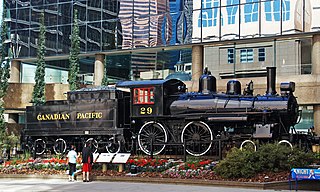
Canadian Pacific Railway No. 29 is a preserved Canadian A-1e class 4-4-0 steam locomotive. It was built by the Canadian Pacific's DeLorimier Shops in 1887 as locomotive No. 390, before being renumbered 277 in 1905. It was renumbered again to 29 after being rebuilt in 1912. By the 1950s, No. 29 was the youngest of three CPR 4-4-0s that were regularly used on the Norton-Chipman mixed train. After being retired from the Canadian Pacific in 1960, the locomotive was donated to the Canadian Railway Museum in Saint-Constant, Quebec for static display. In 1983, No. 29 was acquired by the Salem and Hillsborough Railway, and it was then moved to Hillsborough, New Brunswick, for further display. It was subsequently restored to operating condition for the locomotive's 100th birthday in 1987. In late 1994, No. 29 fell victim to a shed fire that would put an end to the locomotive's S&H career. Two years later, the locomotive was reacquired by the Canadian Pacific, who moved and cosmetically restored it for static display in front of their headquarters in Calgary, Alberta. In 2017, the locomotive was moved again to the CPR's new headquarters in Ogden yard. Although the locomotive is in good condition, an operational restoration on No. 29 would be expensive.




